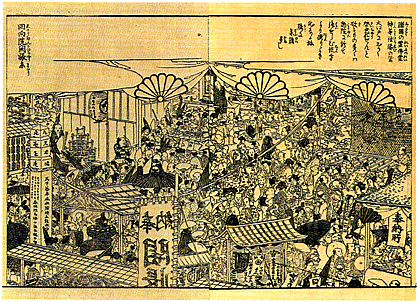 | |
|
The Ekôin and the Sensôji (in Asakusa) were famous Edo sites for kaichô or temple fairs. "Kaichô" literally means "display of a holy image" and refers to special times during the year when, with government permission, certain Buddhist icons were unveiled for public viewing. Icons were often brought to Edo from temples around the country (the kaichô pictured here is for a statue of the Buddha from a temple in Saga domain). Besides the display of feature icons, booths for exhibiting other religious objects and for selling amulets and refreshments were also set up. Since kaichô were magnets for crowds, secular spectacles (misemono) ranging from peep shows and freak shows to storytellers and magicians quickly filled the area around the temple, thus linking kaichô to misemono at Ryôgoku. With respect to misemono peep shows that involved women exposing their genitals to paying customers, there's probably some connection between the orthodox meaning of the word "kaichô" and the Edo-period slang term "kaichô" that meant "female genitals" or their display. | |
|
|
|